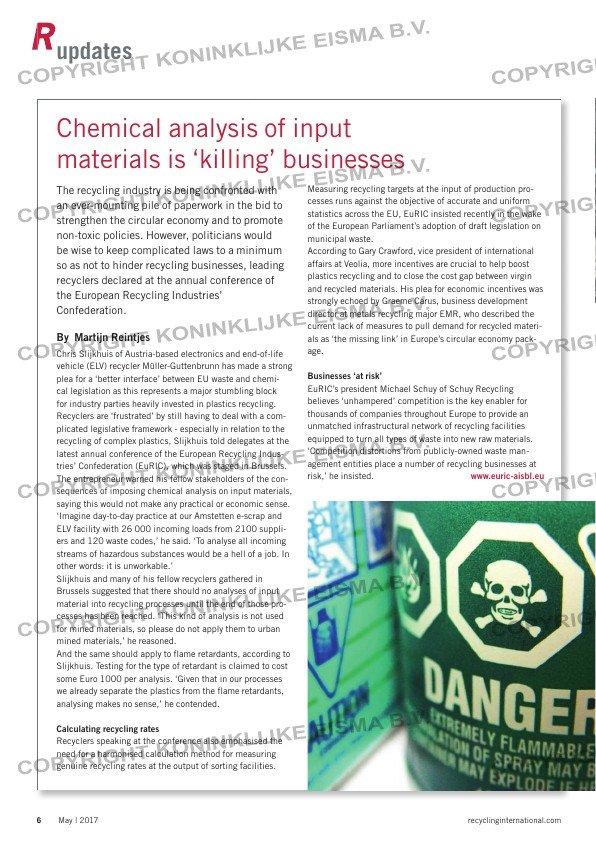Page 8 from: Edition 3 2017

6 May | 2017
updates
recyclinginternational.com
Chemical analysis of input
materials is ‘killing’ businesses
The recycling industry is being confronted with
an ever-mounting pile of paperwork in the bid to
strengthen the circular economy and to promote
non-toxic policies. However, politicians would
be wise to keep complicated laws to a minimum
so as not to hinder recycling businesses, leading
recyclers declared at the annual conference of
the European Recycling Industries’
Confederation.
By Martijn Reintjes
Chris Slijkhuis of Austria-based electronics and end-of-life
vehicle (ELV) recycler Müller-Guttenbrunn has made a strong
plea for a ‘better interface’ between EU waste and chemi-
cal legislation as this represents a major stumbling block
for industry parties heavily invested in plastics recycling.
Recyclers are ‘frustrated’ by still having to deal with a com-
plicated legislative framework – especially in relation to the
recycling of complex plastics, Slijkhuis told delegates at the
latest annual conference of the European Recycling Indus-
tries’ Confederation (EuRIC), which was staged in Brussels.
The entrepreneur warned his fellow stakeholders of the con-
sequences of imposing chemical analysis on input materials,
saying this would not make any practical or economic sense.
‘Imagine day-to-day practice at our Amstetten e-scrap and
ELV facility with 26 000 incoming loads from 2100 suppli-
ers and 120 waste codes,’ he said. ‘To analyse all incoming
streams of hazardous substances would be a hell of a job. In
other words: it is unworkable.’
Slijkhuis and many of his fellow recyclers gathered in
Brussels suggested that there should no analyses of input
material into recycling processes until the end of those pro-
cesses has been reached. ‘This kind of analysis is not used
for mined materials, so please do not apply them to urban
mined materials,’ he reasoned.
And the same should apply to flame retardants, according to
Slijkhuis. Testing for the type of retardant is claimed to cost
some Euro 1000 per analysis. ‘Given that in our processes
we already separate the plastics from the flame retardants,
analysing makes no sense,’ he contended.
Calculating recycling rates
Recyclers speaking at the conference also emphasised the
need for a harmonised calculation method for measuring
genuine recycling rates at the output of sorting facilities.
Measuring recycling targets at the input of production pro-
cesses runs against the objective of accurate and uniform
statistics across the EU, EuRIC insisted recently in the wake
of the European Parliament’s adoption of draft legislation on
municipal waste.
According to Gary Crawford, vice president of international
affairs at Veolia, more incentives are crucial to help boost
plastics recycling and to close the cost gap between virgin
and recycled materials. His plea for economic incentives was
strongly echoed by Graeme Carus, business development
director at metals recycling major EMR, who described the
current lack of measures to pull demand for recycled materi-
als as ‘the missing link’ in Europe’s circular economy pack-
age.
Businesses ‘at risk’
EuRIC’s president Michael Schuy of Schuy Recycling
believes ‘unhampered’ competition is the key enabler for
thousands of companies throughout Europe to provide an
unmatched infrastructural network of recycling facilities
equipped to turn all types of waste into new raw materials.
‘Competition distortions from publicly-owned waste man-
agement entities place a number of recycling businesses at
risk,’ he insisted. www.euric-aisbl.eu



